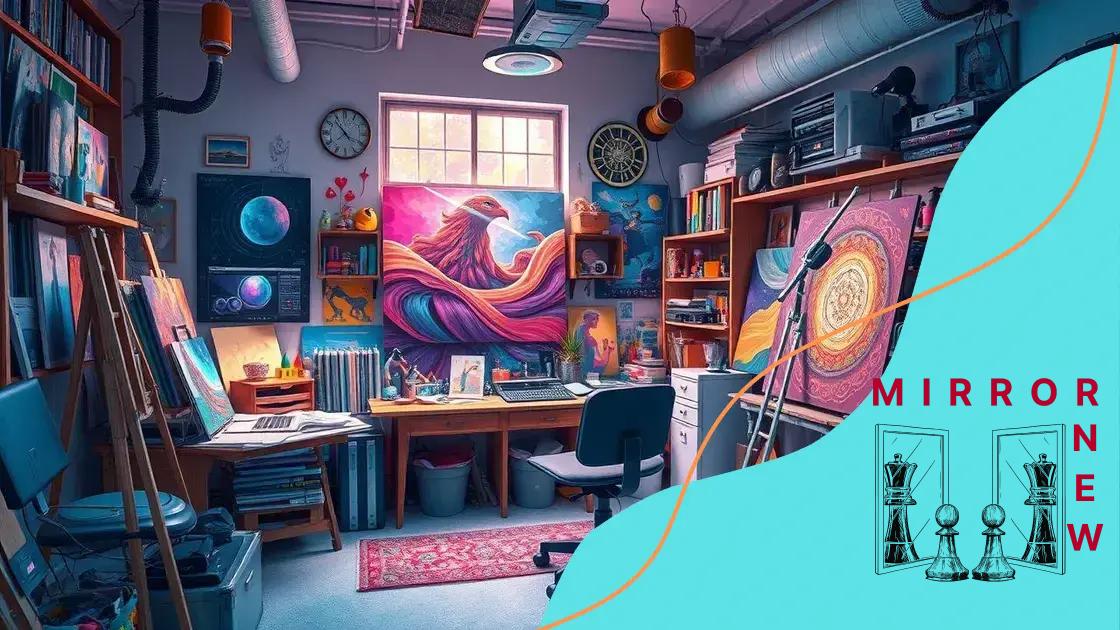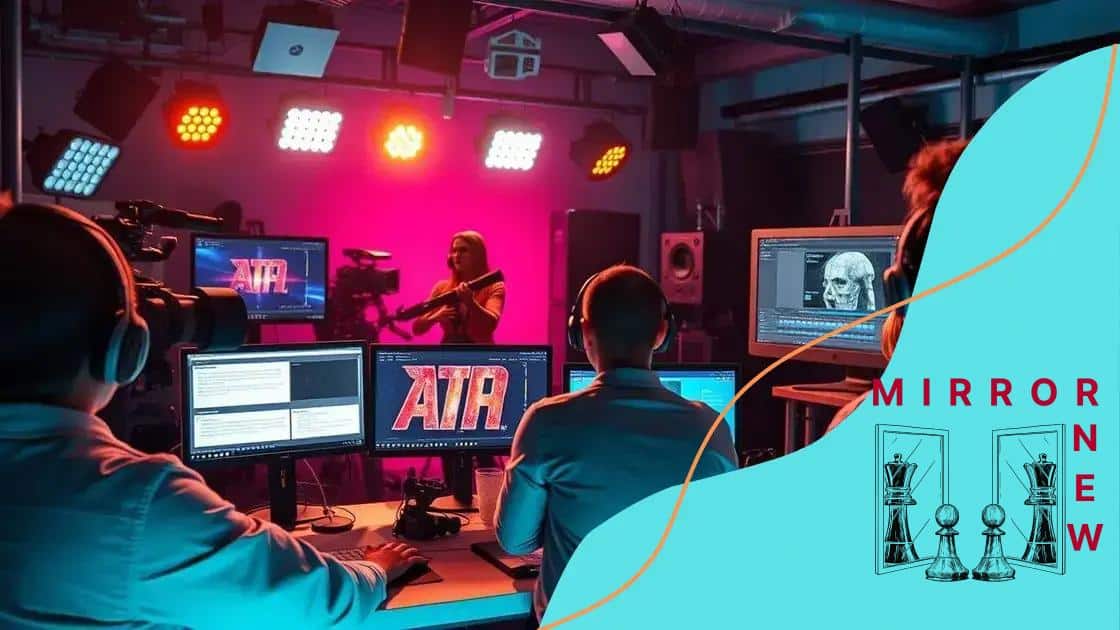The role of AI in transforming the creative industries

The role of AI in transforming the creative industries includes enhancing artistic expression, personalizing experiences, and enabling innovative collaboration between humans and machines for new forms of art, music, and film.
The role of AI in transforming the creative industries is a fascinating topic that raises many questions. How do these advancements influence artists and creators? Let’s dive into the insights behind this evolution.
How AI is changing artistic expression
AI is changing artistic expression in remarkable ways. As artists and creators explore new mediums, AI has become a tool that pushes the boundaries of traditional art forms.
From complex algorithms generating stunning visuals to music creation software that composes original melodies, the influence of AI is reshaping our perception of creativity.
How AI Enhances Art Creation
Artists are using AI to enhance their work, blending human creativity with machine learning. This collaboration opens up new avenues for expression and invites innovative styles, such as:
- Generative art that evolves over time
- Interactive installations that engage audiences
- AI-assisted design tools for graphic creation
- Real-time music generation in performances
These advancements not only create unique pieces but also challenge our understanding of artistry. Can a piece created by a machine still be considered art? This question drives the discourse around AI’s role in the creative sector.
The Impact on Traditional Artists
Traditional artists are feeling the impact of AI as well. They can leverage AI tools to explore different styles or generate variations of their work. Some artists have embraced this, while others worry about the authenticity of their creations. Regardless, the integration of AI does foster collaboration across various artistic disciplines.
As artists experiment with AI, they discover new textural qualities and methods of storytelling. No longer limited to brushes and canvases, they can now create with data and algorithms, thereby expanding their repertoire significantly. With these tools, artists can access vast libraries of inspiration and automate repetitive tasks, allowing for more focus on creativity itself.
While AI is changing artistic expression, we must also consider the ethical implications. Questions arise about authorship and ownership. If a machine generates a piece of art, who is the true creator? Artists and technologists need to navigate these complex landscapes together.
Future of Art in an AI World
Looking ahead, we see endless possibilities for AI in the arts. Whether it’s through virtual reality experiences or AI-generated art exhibitions, creative industries will continue to evolve. Artists embracing these changes will lead the way in this new artistic frontier.
Therefore, as we observe the relationship between AI and creativity, we must remain open to new forms and expressions that challenge conventional wisdom. Each breakthrough invites discussions that enrich the artistic dialogue, ensuring that creativity never stands still.
The impact of AI on music production
The impact of AI on music production has been profound and far-reaching. By integrating advanced algorithms into the creative process, musicians and producers can now achieve results that were once unimaginable.
AI tools are reshaping the way music is composed, recorded, and produced. From simplifying the technical aspects to enhancing creative choices, AI empowers artists in unprecedented ways.
Revolutionizing Composition
Composers are now using AI software to assist in writing music. This software can analyze vast datasets of existing songs and suggest new melodies, chord progressions, and even lyrics. The benefits include:
- Faster song creation through automation
- Inspiration from new styles and genres
- The ability to generate variations for refining ideas
- Enhanced collaboration between human composers and AI tools
With these tools, artists can break free from traditional constraints and explore uncharted territories in creativity. As a result, we see the emergence of unique musical styles that blend human emotion with machine precision.
Changing the Production Landscape
AI is also impacting how music is produced. With machine learning, sound engineers can optimize mixing and mastering processes. This advancement leads to:
- Improved sound quality through smart adjustments
- Time savings during the editing phase
- Cost reductions by minimizing the need for extensive studio time
Producers are now able to take advantage of AI-driven tools that can analyze tracks and provide feedback. This efficiency allows them to focus more on creativity rather than getting bogged down in technicalities.
AI’s presence in music production signifies a shift towards an interactive partnership between artists and technology. Musicians are not just users of these tools; they are discovering how to collaborate and innovate alongside AI.
This partnership embodies an exciting time for the music industry, where AI is reshaping the process. As technology continues to advance, we can expect even more innovative breakthroughs that will redefine how we experience music.
AI’s role in film and video creation

AI’s role in film and video creation is becoming increasingly vital. With technological advancements, filmmakers are exploring how artificial intelligence can enrich storytelling and streamline production processes.
AI systems can analyze large datasets, helping creators understand audience preferences and trends. This capability is changing the way films are developed, marketed, and distributed. Additionally, AI is being integrated into various stages of production, from pre-production planning to post-production editing.
Enhancing Scriptwriting
Writers are now using AI tools to help with script development. These tools can suggest plot ideas, character arcs, and dialogues. This process allows for:
- Increased creativity and idea generation
- Faster turnaround in script drafts
- Insights based on successful storytelling patterns
By harnessing the power of machine learning, writers can focus more on their creative process while making data-driven decisions on plotlines.
Streamlining Production
During filming, AI can optimize various aspects of production. This includes managing schedules, coordinating crew members, and even automating camera work. Some benefits include:
- Improved efficiency and organization
- Better resource allocation
- Enhanced creativity by allowing artists to concentrate on their craft
AI-powered tools can analyze scenes while filming, offering real-time feedback that helps directors make more informed choices on set.
In the editing room, AI can assist by suggesting cuts, pacing, and even color grading. This technology reduces the burdens of post-production, allowing editors to experiment with different styles more freely. As a result, filmmakers are finding new ways to tell compelling stories that resonate with audiences.
The cinematic landscape is changing rapidly as AI plays a crucial role in film and video creation. By embracing these innovations, filmmakers are not only enhancing their craft but also exploring uncharted territories in visual storytelling.
Challenges of AI in creative sectors
The challenges of AI in creative sectors are significant and multifaceted. While AI offers many benefits, it also raises unique issues that industry professionals must navigate. One primary concern is the question of authorship. When AI creates a piece of art, music, or literature, who owns it? This dilemma can create legal and ethical complications as creators and technologists work together.
Another challenge involves the potential loss of jobs in creative fields. As AI tools become more capable, there is a fear that human creativity may be undervalued. Some artists worry that algorithms could replace rather than enhance their work. However, it’s essential to view AI as a collaborative partner rather than merely a replacement.
Overcoming Resistance to Change
Many in the creative sectors may resist adopting AI technologies. This reluctance can stem from a lack of understanding or fear of the unknown. To foster acceptance, education is vital. Professionals should learn how to integrate AI tools into their existing processes safely and effectively. They need to see the value that these technologies can bring to their work.
Ethical Considerations
Moreover, ethical considerations regarding AI usage in creative industries are prominent. Decisions made by algorithms can often seem opaque. As AI systems analyze data to make creative decisions, potential biases inherent in the training data can lead to unfair representations. This scenario necessitates careful evaluation to ensure that AI supports diversity and inclusion rather than exacerbating existing inequalities.
Furthermore, as AI continues to evolve, the boundaries of creativity shift. It prompts society to rethink what creativity means in an age where machines can generate impressive artistic outputs. As AI challenges traditional notions, artists must adapt and redefine their roles within this new landscape.
Future trends of AI in creativity
The future trends of AI in creativity are poised to revolutionize how we approach art, music, and filmmaking. As technology continues to advance, we can expect even more seamless integration of AI tools into the creative process.
One emerging trend is the increased collaboration between humans and AI. Rather than competing, artists, musicians, and filmmakers are beginning to see AI as a supportive partner. This partnership enhances creativity by providing new perspectives and ideas. For instance, AI can analyze vast amounts of data to suggest innovative concepts that artists may not have considered.
Personalized Content Creation
Another important trend is personalized content generation. Using AI, creators can tailor their work to meet the preferences of specific audiences. This means:
- Creating music playlists based on individual listening habits
- Generating personalized art that reflects user interests
- Producing films that cater to specific viewer demographics
As AI tools become smarter, they will enable creators to craft unique experiences that resonate deeply with audiences, making art more engaging.
Interactive and Immersive Experiences
We are also likely to see a rise in interactive and immersive experiences powered by AI. Technologies such as virtual reality (VR) and augmented reality (AR) will integrate AI to create dynamic storytelling environments. This innovation will take creativity to new heights, allowing audiences to:
- Engage with art installations through physical interactions
- Participate in virtual concerts with real-time AI-generated visuals
- Experience films that adapt based on viewer choices
The possibilities for rich, interactive experiences are endless. As AI continues to shape creative sectors, we can anticipate an exciting future where art becomes a two-way experience between creators and audiences.
FAQ – Frequently Asked Questions about AI in Creative Industries
How does AI enhance artistic expression?
AI provides tools that allow artists to explore new styles and ideas, facilitating collaboration that leads to unique artistic creations.
What are the ethical concerns regarding AI in creativity?
Ethical concerns include authorship issues, potential job displacement, and the need to address biases in AI-generated content.
Can AI personalize creative experiences?
Yes, AI can analyze user preferences to create tailored art, music, and media that resonates with individual audiences.
What is the future of AI in the creative process?
The future includes deeper collaboration between humans and AI, leading to immersive interactive experiences and novel artistic expressions.





